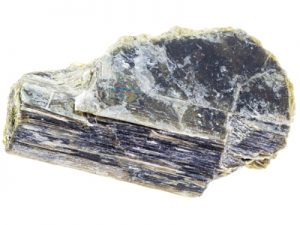Granite is a composite of magma and different kinds of minerals such as quartz, feldspar, amphiboles, and mica. The mineral mica is found in a lot of granite, and it is one of the things that gives granite a shimmery shine in certain places. Whether you already have granite countertops or other granite surfaces or if you're thinking about having granite installed, here are a few things you should know about mica.

Mica forms in sheets like a book.
What is mica?
Mica is a highly reflective natural substance that forms in sheets, like the pages of a book. It ranges in color from clear to black. If you have granite, then you more than likely have mica to some degree. Delicatus White, Volga Blue and Cosmos are examples of granites that have a bit more mica than most. A lot of mica can make a slab incredibly beautiful, but it can potentially cause some issues.
Potential Problems With Mica
The BIG issue is that mica is brittle. When we think about the granite, we think of durable, hard, rock. Due to mica's brittleness, there may be some fabrication issues with granite that has a high mica content. When mica gets cut, it breaks, causing crumbling, pitting, and flaking. Fabricators may charge you extra to fabricate slabs with a lot of mica, because they know they will have to repair the slabs during the fabrication process.
If your granite countertop has a lot of mica, think about going with a simple edge like a pencil round or eased edge. A triple pencil or waterfall edge takes more fabrication and opens up more edge surface for mica to chip out, both before and after install.
What happens after the install?
Maybe nothing. Maybe some chipping. One day when you are doing your routine clean up, you may notice the sponge catches on a rough, flaky area that you never felt before. If this happens, don't worry. Your granite countertop is not falling apart. More than likely, what has happened is that a piece of mica has chipped out.
If routine cleaning or normal wear and tear cause pieces of mica to flake out of your countertop, you can call your stone restoration technician to fix the spot. In most cases, there won't be any problem with the repair, however, repair can be difficult or impossible for very large or awkwardly placed chips. Also, be aware that there is nothing any stone restoration contractor can do to prevent future chips.
What should you do about mica?
There is a myth that applying a sealer to granite will help prevent mica from chipping. This is simply not true, however, you can discuss other protection options with your stone restoration technician or fabricator. They can take into consideration your particular stone, the environment where it is or will be installed, your budget, and intended use and then make a recommendation for a protective treatment or film to help prevent chipping. This can be applied to a brand new installation or an existing one.
For new countertops, your fabricator will know if any shine on the granite is an abundance of mica or something else. If the shimmering beauty it creates is worth the possible occasional chip, then everything is okay. If not, you can always look at colors that contain a little less mica.
This article is one of a series of articles written and published on behalf of Surface Care PRO Partners.

